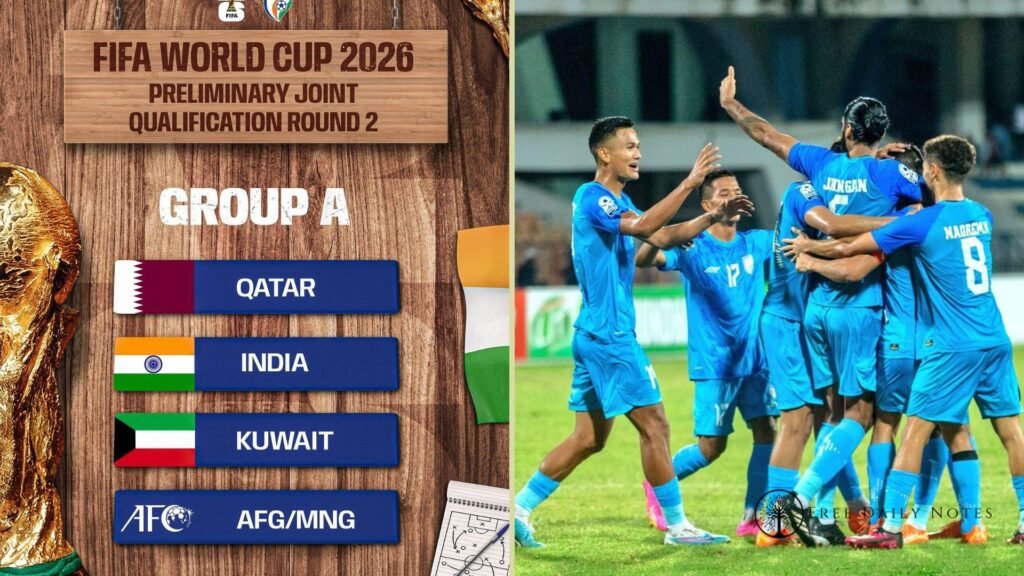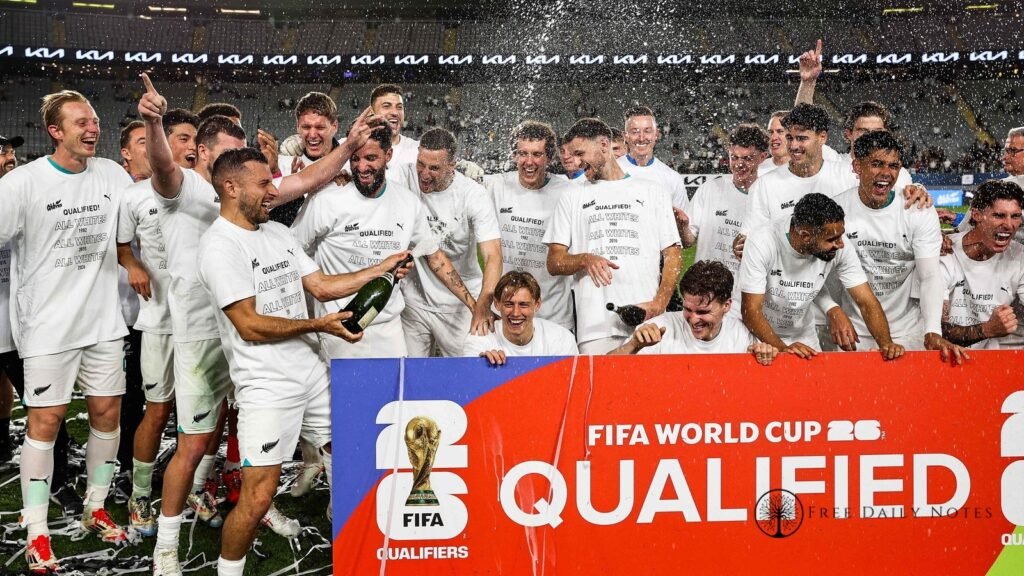I still remember the night in 2022 when Argentina lifted the World Cup trophy in Qatar. The streets of Mumbai erupted in celebration—Messi jerseys everywhere, firecrackers going off at 3 AM, and WhatsApp groups buzzing with memes and match analyses. That’s the magic of the World Cup, isn’t it? Even in a cricket-mad nation like ours, football fever takes over every four years.
But here’s the thing: the next FIFA World Cup 2026 is going to be unlike anything we’ve seen before. The tournament is undergoing its biggest transformation since its inception, and for us Indian football enthusiasts, this could be particularly significant.
Let me walk you through what’s coming, why it matters to us in India, and dare I dream? Whether our Blue Tigers might finally have a realistic shot at qualification.
The Revolution | How FIFA World Cup 2026 Changes Everything We Know About the Tournament
First off, I need to address the elephant in the room. The 2026 World Cup is MASSIVE. No, really—I’m not just throwing around adjectives here. We’re talking about the first-ever 48-team World Cup, spread across three countries, featuring 16 cities and stadiums. The scale is genuinely unprecedented.
When FIFA first announced this expansion, I was skeptical. “Another money grab,” I thought. But after diving deeper into the implications, especially for countries like India, I’ve changed my tune somewhat. Here’s why this matters:
The expansion means 16 more nations get to experience World Cup football. That’s 16 more dreams, 16 more countries whose fans will go absolutely bonkers with excitement. In practical terms, Asia’s qualification spots have jumped from 4.5 to 8.5. That’s nearly double! For a continent where football development has been uneven but passionate, this is significant.
But wait there’s actually something even more intriguing about the FIFA World Cup 2026 format. The traditional group stage with groups of four teams? Gone. Instead, we’re looking at 16 groups of three teams each. Only two matches in the group stage per team. Every match becomes exponentially more crucial. One bad day, and your World Cup dreams could be over before they’ve properly begun.
Actually, that’s not quite right—FIFA has been reconsidering this three-team format due to concerns about potential collusion in the final group matches. The latest reports suggest they might revert to four-team groups despite the increased number of matches. The planning for this World Cup has been nothing if not fluid!
The Hosts | North America’s FIFA World Cup 2026 Vision

The United States, Canada, and Mexico are jointly hosting the FIFA World Cup 2026. Now, I’ve got to say—as someone who’s obsessively followed the World Cup since France ’98, this tri-nation hosting arrangement fascinates me. It’s like three distinct football cultures coming together, each bringing something unique to the table.
Mexico offers a rich football heritage, the US brings state-of-the-art infrastructure and growing football enthusiasm, while Canada, well, they’re the wildcards, hosting men’s World Cup matches for the first time ever.
For Indian fans, this presents both challenges and opportunities. The challenge? North America is literally on the opposite side of the world from us. The opportunity? Multiple host cities mean a variety of potential destinations if you’re planning that once-in-a-lifetime World Cup trip.
The host cities are spread across the continent:
- United States: Atlanta, Boston, Dallas, Houston, Kansas City, Los Angeles, Miami, New York/New Jersey, Philadelphia, San Francisco Bay Area, Seattle
- Mexico: Guadalajara, Mexico City, Monterrey
- Canada: Toronto, Vancouver
I’m particularly excited about the matches in Los Angeles and New York—cities with significant Indian diaspora populations. If you’re planning to go, reaching out to relatives or friends there might save you some serious cash on accommodation!
FIFA World Cup 2026 Qualification Path | Can India Finally Break Through?
Let me share something personal—I’ve been following Indian football since the early 2000s, through all the disappointments, rare triumphs, and eternal hope. The question that haunts every Indian football fan remains: Will we ever see our country at the World Cup?
The FIFA World Cup 2026 qualification process genuinely offers the best chance in our history. With Asia now getting 8.5 spots, the door has cracked open just a bit wider.
But this is significant but we need to be realistic about where Indian football currently stands. As I write this in 2025, India ranks somewhere in the 100s in the FIFA rankings. The traditional Asian powerhouses Japan, South Korea, Australia, Iran, Saudi Arabia remain far ahead. Then there’s the rapid rise of teams like Qatar, UAE, and Uzbekistan.
The qualification format for AFC (Asian Football Confederation) for the FIFA World Cup 2026 will likely involve multiple rounds:
- First Round: Lower-ranked nations play home-and-away ties
- Second Round: 36 teams divided into nine groups of four, playing home and away
- Third Round: Two groups of six teams, with top two from each qualifying directly
- Fourth Round: Third and fourth-placed teams compete for the 7th and 8th spots
- Intercontinental Playoff: The final AFC team plays against a team from another confederation
For India, the realistic goal should be making it to the Third Round, something we’ve never achieved before. To do this, we’d need to finish in the top two of our Second Round group, which typically includes at least one traditional powerhouse.
I remember speaking with former Indian national team midfielder Renedy Singh at a football clinic in Delhi last year, and he made a point that stuck with me: “Our problem isn’t talent, it’s consistent competitive experience against top teams.” The expanded World Cup format might not get us to the tournament in 2026, but it creates a qualification pathway where our team faces better opposition more regularly, which is crucial for long-term development.
Experiencing the FIFA World Cup 2026 from India | Practical Considerations

Let’s talk timing because this is going to be tricky for us Indian fans. The tournament is likely to run from June to July 2026, which means matches will be broadcast in India at rather inconvenient hours:
- East Coast matches: approximately 9:30 PM to 6:30 AM IST
- West Coast matches: approximately 12:30 AM to 9:30 AM IST
- Mexican and Canadian matches: varying between these times
I still remember the 2014 World Cup in Brazil, setting alarms for 3:30 AM and stumbling bleary-eyed to watch matches before work. The FIFA World Cup 2026 might require similar dedication or some strategic leave planning!
Broadcasting rights haven’t been announced for India yet, but based on recent tournaments, we can expect the matches to be available on a combination of:
- Sony Sports Network
- JioCinema or similar streaming platforms
- Potential new digital platforms as the streaming landscape evolves
Planning to Attend? FIFA World Cup 2026 Tickets from India
If you’re dreaming bigger and want to attend in person, here’s what you need to start thinking about:
- Tickets: Based on Qatar 2022, expect ticket prices to range from ₹5,000 for group matches to upwards of ₹60,000 for later knockout rounds. FIFA typically opens ticket sales about a year before the tournament, with various phases allowing different purchasing options.
- Visa requirements: Indians need visas for all three host countries. The US visa process is notoriously unpredictable for Indians, so start early—ideally 12-15 months before the tournament. Mexico and Canada have somewhat simpler processes, but still require advance planning.
- Budget planning: A bare-bones trip covering just a few group stage matches might cost ₹2.5-3 lakhs per person from India. A more comprehensive experience including knockout matches could easily exceed ₹5 lakhs.
- Travel logistics: The sheer size of North America means you’ll need to carefully plan which venue clusters to focus on. Trying to hop between too many cities will eat into both your budget and enjoyment.
The last World Cup I attended was Russia 2018, A much more accessible destination for Indians both geographically and financially. North America presents different challenges, but if you’re planning to go, joining Indian supporters’ groups like Blue Pilgrims might help with coordinated travel plans and potentially group ticket purchases.
The Expanded FIFA World Cup 2026 Format | What It Means for the Beautiful Game
I’ve spent hours debating this with friends at our local football screenings in Bengaluru. Is a bigger World Cup better or worse for the sport? The purist in me was initially horrified. The football fan who wants the game to grow globally? Much more optimistic.
The expanded FIFA World Cup 2026 format fundamentally changes the tournament’s dynamics. More teams means more potential for surprise packages—think about how Morocco captured hearts in Qatar, now imagine several more such stories.
For us in India, it creates a fascinating scenario: some of our regional neighbors who previously seemed forever stuck in qualification rounds might actually make it. Imagine the excitement if Bangladesh, Nepal, or Sri Lanka qualified? The regional rivalries would be electric.
But there are legitimate concerns too. Will the quality be diluted? Will too many mismatches make group stage games boring? When I put this question to former Indian captain Bhaichung Bhutia at a football development conference in Kolkata early this year, his response was measured: “Any opportunity that gives more nations exposure to top-level football ultimately raises standards across the board. Short-term quality concerns will be outweighed by long-term development benefits.”
The tournament structure also introduces new tactical considerations. With potentially four-team groups returning, and the increased number of knockout matches, team management will be even more crucial. Squad depth, recovery protocols, and adaptive strategies will determine success.
As someone who grew up watching the tactical masterclasses of teams like Spain and Germany, I’m genuinely curious to see how coaches adapt to this new reality. Will we see more defensive approaches in the group stage? Or will the expanded format actually encourage more attacking play since more teams advance to the knockouts?
What the FIFA World Cup 2026 Legacy Could Mean for Indian Football

Here’s where I want to get a bit philosophical about what this all means for us in India. World Cups aren’t just sporting events—they’re cultural phenomena that inspire generations.
I first fell in love with football watching Ronaldo in the 1998 World Cup. For many younger Indian fans, it might have been Messi’s magic in Qatar. Each tournament creates new fans and potentially new players.
The expanded FIFA World Cup 2026 format genuinely offers India a pathway—perhaps not immediately to qualification, but to being part of the global conversation. With more Asian teams participating, the continental qualifying competitions become more significant, more watched, more important.
This creates commercial opportunities too. I’ve noticed how Indian brands have increasingly sponsored Asian football events in recent years. More meaningful competitions could accelerate this trend, potentially bringing more investment into Indian football.
But for all this potential, we need systematic development. The AIFF (All India Football Federation) has made some progress with youth development programs and improved professional structures, but we’re still playing catch-up with much of Asia.
Wait—I’m getting ahead of myself. The expanded World Cup isn’t a magic solution for Indian football’s challenges. It’s merely an opportunity, one that requires tremendous work at grassroots levels to capitalize on.
What I genuinely believe, though, is that the 2026 tournament will be watched by more Indians than any previous World Cup. The primetime North American matches will align better with Indian waking hours than the European or South American editions. More eyeballs means more engagement, more inspiration, and hopefully more kids kicking balls around and dreaming of representing India.
How much would it cost an Indian fan to attend the FIFA World Cup 2026?
Planning to attend the FIFA World Cup 2026 from India requires significant financial preparation. A reasonable budget would be ₹2.5-5 lakhs per person, depending on your plans. This estimate includes: round-trip flights to North America (₹80,000-1,20,000), accommodation for two weeks (₹70,000-1,50,000 depending on location and standard), tickets for 3-5 matches (₹25,000-1,00,000), local transportation (₹30,000-50,000), food and miscellaneous expenses (₹40,000-80,000), plus visa fees and travel insurance. Focusing on matches in a single region rather than traveling between distant host cities can significantly reduce costs. Many Indian fans are already forming travel groups to share accommodation expenses and enhance the experience.
I was eighteen when I watched my first World Cup final in a crowded dormitory common room, surrounded by equally passionate friends arguing over tactics and players. As the 2026 tournament approaches, I can’t help but wonder if this might finally be the catalyst that propels Indian football forward in meaningful ways. The expanded format offers hope, even if qualification remains a distant dream for now.
For us Indian fans, the FIFA World Cup has always been about borrowed allegiances—picking Brazil, Argentina, Germany, or another footballing giant to support. Maybe someday, hopefully in our lifetimes, we’ll get to support our own. Until then, the FIFA World Cup 2026 promises to be the most accessible and potentially influential tournament yet for growing the beautiful game in our cricket-dominated nation.
FAQs
How many countries will participate in the FIFA World Cup 2026?
The FIFA World Cup 2026 will feature 48 teams, a significant expansion from the 32-team format that’s been in place since 1998. This expansion means nearly a quarter of all FIFA member nations will participate, making it the most inclusive World Cup in history. For countries like India, this expanded format theoretically improves qualification chances, as Asia’s allocation has increased from 4.5 to 8.5 spots.
What are India’s chances of qualifying for the FIFA World Cup 2026?
Being brutally honest, India’s chances of qualifying for the FIFA World Cup 2026 remain slim but are better than previous cycles. With Asia getting 8.5 qualification spots, India would need to dramatically improve their FIFA ranking and competitive results over the next year. The realistic goal for the Indian team should be reaching the third round of Asian qualification, which would put them among the top 18 teams in Asia—a significant achievement in itself and a stepping stone toward future qualification campaigns.
How can I buy tickets for the FIFA World Cup 2026 from India?
Buying FIFA World Cup 2026 tickets from India will involve applying through FIFA’s official ticket portal when sales open (likely in 2025). Based on previous tournaments, expect a lottery system for high-demand matches. Indian fans should create a FIFA ticket account well in advance, set up international payment options, and be ready when the various sales phases begin. Ticket prices will likely range from ₹5,000 to over ₹60,000 depending on the match category. Remember that having match tickets significantly improves your chances of obtaining visas to the host countries.
How will the time difference affect watching the FIFA World Cup 2026 in India?
The FIFA World Cup 2026 matches will be held across three North American countries, creating varying kickoff times when viewed from India. Most matches will likely fall between 9:30 PM to 9:30 AM IST. East Coast matches will generally be more viewer-friendly for Indians, while West Coast games might require early morning viewing. The silver lining is that weekend matches and knockout stages could align better with Indian viewing times than previous World Cups in Europe or South America, potentially leading to record viewership numbers in India.
What is the new format for the FIFA World Cup 2026 group stages?
The FIFA World Cup 2026 format has been subject to ongoing revisions. Initially, FIFA announced a format with 16 groups of three teams each, but concerns about potential collusion in final group matches have led them to reconsider. The latest indications suggest a possible return to four-team groups despite the increased total of teams. This would mean each team plays three group matches, with the top two from each group advancing, plus the best third-placed teams. However, FIFA has yet to finalize this aspect of the tournament structure, so Indian fans should stay updated on official announcements.






